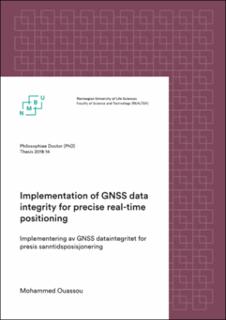| dc.contributor.advisor | Gjevestad, Jon Glenn | |
| dc.contributor.author | Ouassou, Mohammed | |
| dc.date.accessioned | 2020-11-25T14:52:20Z | |
| dc.date.available | 2020-11-25T14:52:20Z | |
| dc.date.issued | 2018 | |
| dc.identifier.isbn | 978-82-575-1488-4 | |
| dc.identifier.issn | 1894-6402 | |
| dc.identifier.uri | https://hdl.handle.net/11250/2689622 | |
| dc.description.abstract | In recent years, the area of global navigation satellite systems (GNSS) has received a lot of attention, with a large range of fruitful results. This includes systems; the advent of European (Galileo) and Chinese (Beidou) systems; a modernization of the existing American (GPS) and Russian (GLONASS) systems; the advent of European (Galileo) and Chinese (Beidou) systems;the adoption of multiple civilian frequencies for the broadcasts; and novel algorithms needed to process the ever-growing data sets. In total, this has resulted in more reliable positioning services for the GNSS end-users.
Network real-time kinematic (NRTK) positioning services have especially benefited from these recent developments. However, one weakness that the current generation of NRTK software still suffers from, is that the end-users do not know to what degree they can trust the results. To perform such a quality-check, post-processing of the data is required – and a decision has to be made regarding whether to acquire new data. The current situation will not satisfy the needs of future NRTK users, who are increasingly demanding real-time information about the data quality, i.e. that integrity information is made available simultaneously with the positioning data itself.
The purpose of this thesis is to design and implement such an NRTK data integrity solution. The guiding concept behind the algorithms presented will be to exert a continuous control over the GNSS information across three different levels: the network corrections, the baseline, and the rover data.
The integrity monitoring algorithms developed and described in this thesis are NRTK-agnostic, and work regardless of the method used for generation of the NRTK corrections. However, for derivation and development of the integrity and quality control algorithms we have based our work on the conceptual approach as given by the NetAdjust method [89, 90]. Most of the NRTK techniques are developed commercially and details about these are not readily available. But the NetAdjust method is well described in literature, it is therefore suitable as a starting point for our work, and we provide a review of the method in coming chapters.
The algorithms were tested using data from the Norwegian RTK network known as CPOS operated by the Norwegian Mapping Authority (NMA). The test area is from the Rogaland region in the south west of Norway, covering an area of 150 km × 150 km and composed of six reference receivers. Reference receivers are equipped with Trimble NetR9 receivers, tracking GPS and GLONASS satellite signals. Baselines vary between 35–112 km and the height difference between the sites is about 225 m. | en_US |
| dc.description.sponsorship | Kartverket, Geodesidivisjonen | en_US |
| dc.language.iso | eng | en_US |
| dc.publisher | Norwegian University of Life Sciences, Ås | en_US |
| dc.relation.ispartofseries | PhD Thesis;2018:14 | |
| dc.rights | Attribution-NonCommercial-NoDerivatives 4.0 Internasjonal | * |
| dc.rights.uri | http://creativecommons.org/licenses/by-nc-nd/4.0/deed.no | * |
| dc.title | Implementation of GNSS data integrity for precise real-time positioning | en_US |
| dc.title.alternative | Implementering av GNSS dataintegritet for presis sanntidsposisjonering | en_US |
| dc.type | Doctoral thesis | en_US |

